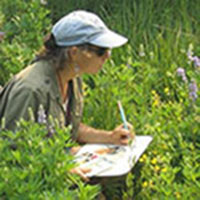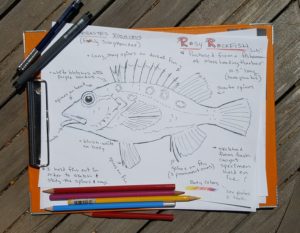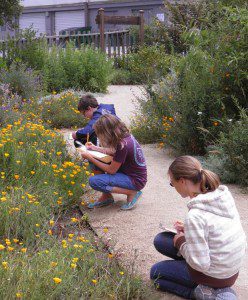When students ask “Teach me how to draw a butterfly, rose, horse, bald eagle, (fill in the blank)” they are really asking me two things and that’s what I’d like to cover in today’s challenge.
Learning to draw anything involves two components; skills and knowledge. Skills refers to the kinds of foundational drawing skills such as depicting shape, form, texture, color, etc. In this free nature sketching challenge, I’ve focused on shape, because this element is truly the foundation upon which all other skills are built. If you’d like to learn how to depict the other elements, you may want to join my sketching club which I’ll tell you more about later.
After skills comes knowledge, meaning knowledge of the anatomy, behavior, habitat, and ecology of the subject you’d like to draw. For example, when we learned to sketch a robin, we noticed that as a bird it had wings, feathers, and a beak, and as a robin specifically it had a characteristic thrush family songbird shape and a distinct color pattern. If we wanted to go further in creating an even more realistic drawing of a robin, we might include its common habitat of backyard lawns, perhaps with a worm in its mouth.
Similarly, if we wanted to draw a fish accurately, we’d need to know that most have a torpedo-shaped body that helps to streamline their movements in the water, have a variety of fins specialized for different swimming behaviors, and have scales of various shapes and sizes depending upon the species.
There are many ways to gain knowledge of your subject matter (besides ‘Googling it’!) including observing living specimens, watching videos, reading, studying photographs, taking a class, or interviewing a biologist. And of course, from my viewpoint, one of the best ways to learn about your subject is to simply draw it. You could use photos, but preserved specimens are better, while living organisms are the best. For these, observe them for a while, trying to capture their behavior as they go about their life; moving, feeding, interacting with other organisms. With careful observation, you’ll notice that even plants exhibit behaviors; sunflowers follow the sun, other flowers curl up their petals at night, carnivorous plants capture their insect prey, leaves flutter in a breeze. Sketch your subject from as many angles as possible so that you truly come to understand its anatomy.
Use all methods of observation available to you, which will in part depend upon the size of your subject. Small subjects will be made clearer with a magnifying lens or a dissecting scope. Organisms at a distance can be observed through binoculars or a viewing scope on a tripod.
Adding written notes to your sketches about your observations is another excellent way to learn about your subject. You can also add notes on things you can’t sketch, like sounds or movements, or color patterns if you don’t have colored media.
Thus, skills and knowledge go hand in hand, each serving their purpose, in helping you to create a realistic sketch of your subject.
Think about what you’d like to learn to draw next. Maybe it’s a songbird at your garden’s feeder, or a seashell from a beach vacation. Learn more about your subject in as many ways as would be helpful (not just from ‘Googling it’). Focus first on learning about its anatomy; how it’s built and its behavior; and how it moves those anatomical parts in relation to each other. Focus specifically on how its anatomy and behavior make it different from its closest relatives. For example, if you wanted to draw a butterfly, you might want to know how its anatomy differs from a moth. Another example is from my neck of the woods, in learning to draw a Golden-mantled Ground Squirrel vs a Lodgepole Chipmunk. They both live in the same pine forests of central Oregon but have subtle differences in their size, color patterns, behavior and habitat.
Today’s Challenge
- Choose a subject you’d like to learn how to draw. Learn as much as you can about it, focusing on its anatomy.
- Using a photo or specimen of your subject, create a sketch that includes notes on what you learned.
- Extra credit: Post your sketch or what you learned about your chosen subject on our Facebook page.
Click here to return to Nature Sketching Challenge home page
Show Your Support
If you are finding value in the lessons from this Nature Sketching Challenge, I invite you to consider donating funds to support me in the creation and ongoing improvement of this program. Even the smallest donation helps me to know that I’m providing lessons that inspire, entertain and educate you about the natural world.
Click the Paypal ‘Donate’ button below to donate any amount you wish. You do not need to have a Paypal account to donate, you may choose to use a credit card if you wish. Thank you!







